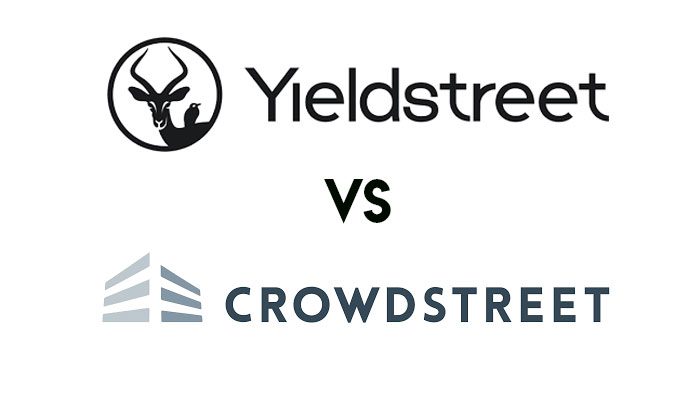Alternative investments are becoming more popular, and new companies offering them are popping up every year.
It can be hard to know which platform is best for you.
This article compares Yieldstreet vs Crowdstreet and helps you make that decision.
While both of these companies have “street” in their name, they are miles apart in their offerings.
What is Yieldstreet?
Yieldstreet is one of the top platforms online for alternative investing.
One thing that sets Yieldstreet apart is the variety of investment options they have. Whether you’re looking for art, short term notes, private equity, or venture capital, Yieldstreet has it and more.
They use crowdfunding to make these investments more accessible to the common person, helping investors diversify in ways they wouldn’t be able to otherwise.
Yieldstreet charges fees between 1-4%, depending on the investment. More on their fees, as well as pros and cons, in this Yieldstreet review.
They focus on investing in individual investments, and give you information to make informed decisions and build your own custom portfolio.
Returns can be high with Yieldstreet, but they also come with high risk.
Yieldstreet uses an Asset-based investment model, and most of their investments are in short-term loans. More on Yieldstreet’s Investment Policy here.
What is Crowdstreet?
Crowdstreet is an online real estate investing platform.
Crowdstreet is only available to accredited investors. In order to qualify as an accredited investor, you must meet certain income, asset, or other specific criteria.
Private equity real estate is the only investment offered by Crowdstreet, but they have several ways that you can invest: Marketplace, C-REIT, or privately managed accounts.
Their marketplace lets you compare and choose the properties you want to invest in, while the C-REIT is an option to invest in many properties at once, though you don’t have control of which properties are in the portfolio.
The minimum amount needed to invest with Crowdstreet is $25,000, which is higher than some platforms, but not as high as other competitors such as First National Realty Partners.
You can find more details about how Crowdstreet works in this Crowdstreet review.
Let’s compare Yieldstreet vs Crowdstreet on some key factors.
Investments offered
Crowdstreet offers private equity real estate investments, while Yieldstreet has a broad range of alternative investments.
Both companies focus on directly investing in individual investments, and they provide information for analyzing and choosing the investments you want.
Both also have a general fund you can invest in if you don’t want to do the work of analyzing and choosing your own: the C-REIT for Crowdstreet and the Prism Fund for Yieldstreet.
Minimum Investment
The minimum investment for Crowdstreet is $25,000. However, some offerings on their marketplace have higher minimums.
For Yieldstreet’s primary offerings, the minimum investment is $10,000, depending on the investment. The Yieldstreet Prism Fund, however, has a minimum of $2,500.
Investment fees
The funds on Crowdstreet can vary quite a bit based on what you’re investing in. For many of their real estate offerings, they charge no fee to the investor. Instead, they charge their fees to the sponsor of the property.
Fees for Crowdstreet’s C-REIT are 2%.
Yieldstreet charges a management fee on all of their offerings, and they range from 1-4%. Fees on their Prism Fund are 1.5%.
Investment Length
This is one of the biggest differences between Yieldstreet and Crowdstreet.
Crowdstreet’s real estate investments are generally locked in for longer periods of time. The average is about 3-5 years, but some can have periods of 10 years. It’s tough to get out of the investment during the investment period.
Yieldstreet’s offerings, however, are generally shorter-term, from 1-3 years. But they also have options for longer investment time horizons.
Yieldstreet vs Crowdstreet: Which is Better for You?
Both Yieldstreet and Crowdstreet focus on accredited investors and have higher minimums than many other comparable companies, but they differ in some key ways.
Crowdstreet is better if you:
- Are accredited and want to choose from a diverse listing of private equity real estate
- Or, are accredited and want to invest in a real estate portfolio that is put together for you
- Want to pay low–or no–fees on individual real estate investments
- Are comfortable with longer investment time periods
- Don’t need easy access to your investment
Yieldstreet is better if you:
- Are looking for alternative investments outside of real estate
- Want shorter investment time periods
- Want riskier and more speculative investment offerings
- Are not accredited and want an easy way invest in alternative investments; consider the Prism Fund
Conclusion
If you want to expand your portfolio with investments outside the typical stocks and bonds, then Yieldstreet and Crowdstreet can be great options.
You’ll want to check them out for yourself to see if they are the right addition to your portfolio.
You can check out Yieldstreet here or Crowdstreet here.



































